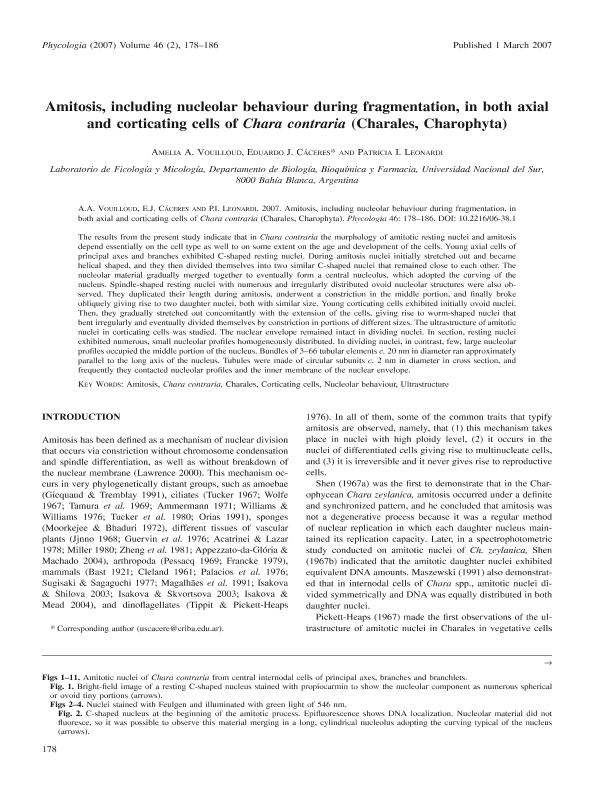Mostrar el registro sencillo del ítem
dc.contributor.author
Vouilloud, Amelia Alejandra Beatriz

dc.contributor.author
Caceres, Eduardo Jorge

dc.contributor.author
Leonardi, Patricia Ines

dc.date.available
2017-10-05T16:36:28Z
dc.date.issued
2007-03
dc.identifier.citation
Vouilloud, Amelia Alejandra Beatriz; Caceres, Eduardo Jorge; Leonardi, Patricia Ines; Amitosis, including nucleolar behaviour during fragmentation, in both axial and cortical cells of Chara contraria (Charales, Charophyta); Int Phycological Soc; Phycologia; 46; 2; 3-2007; 178-186
dc.identifier.issn
0031-8884
dc.identifier.uri
http://hdl.handle.net/11336/25976
dc.description.abstract
The results from the present study indicate that in Chara contraria the morphology of amitotic resting nuclei and amitosis depend essentially on the cell type as well to on some extent on the age and development of the cells. Young axial cells of principal axes and branches exhibited C-shaped resting nuclei. During amitosis nuclei initially stretched out and became helical shaped, and they then divided themselves into two similar C-shaped nuclei that remained close to each other. The nucleolar material gradually merged together to eventually form a central nucleolus, which adopted the curving of the nucleus. Spindle-shaped resting nuclei with numerous and irregularly distributed ovoid nucleolar structures were also observed. They duplicated their length during amitosis, underwent a constriction in the middle portion, and finally broke obliquely giving rise to two daughter nuclei, both with similar size. Young corticating cells exhibited initially ovoid nuclei. Then, they gradually stretched out concomitantly with the extension of the cells, giving rise to worm-shaped nuclei that bent irregularly and eventually divided themselves by constriction in portions of different sizes. The ultrastructure of amitotic nuclei in corticating cells was studied. The nuclear envelope remained intact in dividing nuclei. In section, resting nuclei exhibited numerous, small nucleolar profiles homogeneously distributed. In dividing nuclei, in contrast, few, large nucleolar profiles occupied the middle portion of the nucleus. Bundles of 3–66 tubular elements c. 20 nm in diameter ran approximately parallel to the long axis of the nucleus. Tubules were made of circular subunits c. 2 nm in diameter in cross section, and frequently they contacted nucleolar profiles and the inner membrane of the nuclear envelope.
dc.format
application/pdf
dc.language.iso
eng
dc.publisher
Int Phycological Soc

dc.rights
info:eu-repo/semantics/openAccess
dc.rights.uri
https://creativecommons.org/licenses/by-nc-sa/2.5/ar/
dc.subject
Chara Contraria
dc.subject
Amitosis
dc.subject
Ultrastructure
dc.subject
Charales
dc.subject
Corticating Cells
dc.subject
Nucleolar Behaviour
dc.subject.classification
Bioquímica y Biología Molecular

dc.subject.classification
Ciencias Biológicas

dc.subject.classification
CIENCIAS NATURALES Y EXACTAS

dc.title
Amitosis, including nucleolar behaviour during fragmentation, in both axial and cortical cells of Chara contraria (Charales, Charophyta)
dc.type
info:eu-repo/semantics/article
dc.type
info:ar-repo/semantics/artículo
dc.type
info:eu-repo/semantics/publishedVersion
dc.date.updated
2017-07-12T18:16:10Z
dc.journal.volume
46
dc.journal.number
2
dc.journal.pagination
178-186
dc.journal.pais
Estados Unidos

dc.journal.ciudad
Lawrence
dc.description.fil
Fil: Vouilloud, Amelia Alejandra Beatriz. Universidad Nacional del Sur. Departamento de Biología, Bioquímica y Farmacia; Argentina
dc.description.fil
Fil: Caceres, Eduardo Jorge. Universidad Nacional del Sur. Departamento de Biología, Bioquímica y Farmacia; Argentina
dc.description.fil
Fil: Leonardi, Patricia Ines. Consejo Nacional de Investigaciones Científicas y Técnicas. Centro Científico Tecnológico Conicet - Bahía Blanca. Centro de Recursos Naturales Renovables de la Zona Semiárida. Universidad Nacional del Sur. Centro de Recursos Naturales Renovables de la Zona Semiárida; Argentina
dc.journal.title
Phycologia

dc.relation.alternativeid
info:eu-repo/semantics/altIdentifier/url/http://www.phycologia.org/doi/abs/10.2216/06-38.1
dc.relation.alternativeid
info:eu-repo/semantics/altIdentifier/doi/http://dx.doi.org/10.2216/06-38.1
Archivos asociados
